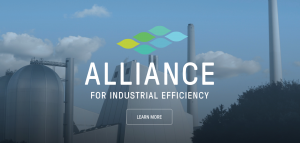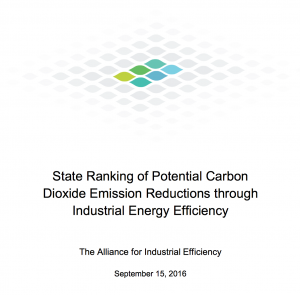David Gardiner and Associates: October Featured Member of the Month
 Virginia could help the industrial sector seize enormous opportunities to cut carbon emissions while saving money and making manufacturers more competitive through industrial energy efficiency. That’s according to Business Gold member David Gardiner and Associates, October’s Featured Member of the Month.
Virginia could help the industrial sector seize enormous opportunities to cut carbon emissions while saving money and making manufacturers more competitive through industrial energy efficiency. That’s according to Business Gold member David Gardiner and Associates, October’s Featured Member of the Month.
A new report by the Alliance for Industrial Efficiency (a project of VAEEC member David Gardiner and Associates) finds that Virginia could reduce carbon emissions by over 2.5 million tons annually by 2030 from industrial energy efficiency – nearly equal to the emissions from a coal-fired power plant – and save the Commonwealth’s businesses over $4 billion on their electricity bills in the process. Industrial energy efficiency could achieve nearly one-third (31 percent) of Virginia’s emission reductions called for under EPA’s Clean Power Plan. Nationwide, industrial efficiency and CHP/WHP could save more than 396 megawatt hours of electricity; 174 short tons of carbon dioxide (the equivalent of 46 coal-fired power plants); and $298 billion in utility bill savings.
 VAEEC member, David Gardiner and Associates (DGA), is an Arlington-based strategic advisory firm focused on climate change, clean energy, and sustainability that helps clients with strategic planning, research and analysis, and improved communications through partnership building and advocacy. The Alliance for Industrial Efficiency, a project of DGA, promotes state and federal policies to support U.S. manufacturing competitiveness through enhanced industrial efficiency. The Alliance’s diverse coalition of businesses, labor groups, and non-profits work to improve energy efficiency in America’s industrial sector.
VAEEC member, David Gardiner and Associates (DGA), is an Arlington-based strategic advisory firm focused on climate change, clean energy, and sustainability that helps clients with strategic planning, research and analysis, and improved communications through partnership building and advocacy. The Alliance for Industrial Efficiency, a project of DGA, promotes state and federal policies to support U.S. manufacturing competitiveness through enhanced industrial efficiency. The Alliance’s diverse coalition of businesses, labor groups, and non-profits work to improve energy efficiency in America’s industrial sector.
In September, the Alliance for Industrial Efficiency released a report ranking U.S. states by their ability to slash carbon emissions through industrial energy efficiency. As the industrial sector is the largest energy user in the U.S. economy, improving its efficiency could significantly reduce emissions in the electricity sector nationwide.
 The report highlights a key tool for states looking to reduce emissions to comply with the Obama administration’s Clean Power Plan or exploring options for utility planning. It also shines a light on an opportunity for manufacturing, mining, construction, and agricultural industries to realize dramatic savings through investments in industrial energy efficiency and combined heat and power (CHP) and waste heat to power (WHP) technologies—the practice of powering and heating industrial facilities with otherwise-wasted resources and energy. Even in the absence of the Clean Power Plan, improving energy efficiency in the industrial sector makes business sense and can save industry billions of dollars in avoided energy costs.
The report highlights a key tool for states looking to reduce emissions to comply with the Obama administration’s Clean Power Plan or exploring options for utility planning. It also shines a light on an opportunity for manufacturing, mining, construction, and agricultural industries to realize dramatic savings through investments in industrial energy efficiency and combined heat and power (CHP) and waste heat to power (WHP) technologies—the practice of powering and heating industrial facilities with otherwise-wasted resources and energy. Even in the absence of the Clean Power Plan, improving energy efficiency in the industrial sector makes business sense and can save industry billions of dollars in avoided energy costs.
“This report demonstrates that we can cut carbon while saving businesses money,” said Jennifer Kefer, Executive Director, Alliance for Industrial Efficiency. “With this analysis, we have exposed the myth that clean energy and manufacturing competitiveness are in conflict. To the contrary, by investing in industrial efficiency, we can reduce emissions while simultaneously slashing utility bills, creating jobs, and strengthening our industrial sector.”
Download the Alliance’s report and fact sheets.
